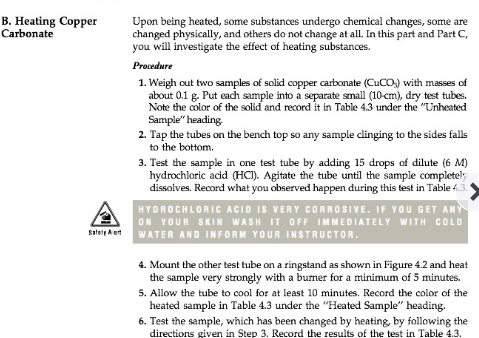B. Heating Copp Carbonate Upon being heated, some substances undergo chemical changes, some are changed physically, and others do not change at all In this part and Part C, you Procedure will investigate the effect of heating substances. 1. Weigh out two samples of solid copper carbonate (CuCO with masses of about 0.1 g. Put each sample into a separate small (10-cm), dry test tubes Note the color of the soid and record it in Table 43 under the "Unheated Sample" heading 2. Tap the tubes on the bench top so any sample clinging to the sides falls to the bottom. 3. Test the sample in one test tube by adding 15 drops of dilute (6 M) hydrochloric acid (HCl). Agitate the tube until the sample completely disalves. Record what you observed happen during this lest in Table 4.3 HYDROCHLORIC ACID IS VERY CORROSIVE. IF YOU GET AN ON YOUR SKIN WASH IT OFF IMMEDIATELY WITH COLD WATER AND INFORM YOUR INSTRUCTOR 4. Mount the other test tube on a ringstand as shown in Figure 4.2 and heat the sample very strongly with a burner for a minimum of 5 minutes. 5. Allow the tube to cool for at least 10 minutes. Record the color of the heated sample in Table 4.3 under the "Heated Sample" heading. 6. Test the sample, which has been changed by heating, by following the directions given in Step 3. Record the results of the test in Table 4.3.
Ionic Equilibrium
Chemical equilibrium and ionic equilibrium are two major concepts in chemistry. Ionic equilibrium deals with the equilibrium involved in an ionization process while chemical equilibrium deals with the equilibrium during a chemical change. Ionic equilibrium is established between the ions and unionized species in a system. Understanding the concept of ionic equilibrium is very important to answer the questions related to certain chemical reactions in chemistry.
Arrhenius Acid
Arrhenius acid act as a good electrolyte as it dissociates to its respective ions in the aqueous solutions. Keeping it similar to the general acid properties, Arrhenius acid also neutralizes bases and turns litmus paper into red.
Bronsted Lowry Base In Inorganic Chemistry
Bronsted-Lowry base in inorganic chemistry is any chemical substance that can accept a proton from the other chemical substance it is reacting with.
4. A student performs the HCl tests on the three solid samples as described in Step 5 of Part B and gets the same result for the solid CaCO3 sample and the mixture. Which of the following statements is true concerning these results?
Explain your answer.

Trending now
This is a popular solution!
Step by step
Solved in 2 steps with 1 images







